How To Shuffle A Pack Of Cards In Blackjack?
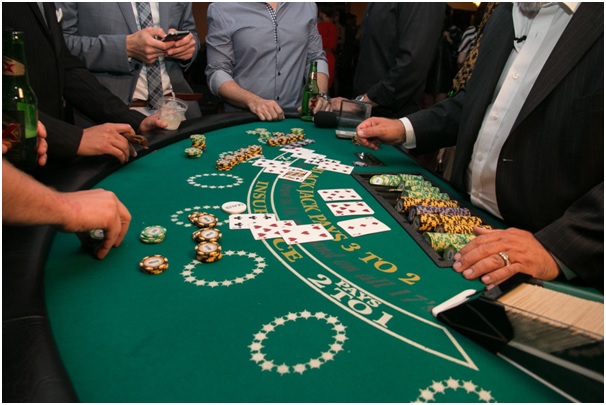
It might be seeming very easy to you the way the dealer shuffles the cards on the table. When you play online Blackjack with a live dealer just watch how smoothly the shuffle of cards happen. But this is not so easy as you think. Shuffling of cards too require some technique and logic practice. Here we have gathered some information to let you know the few types of techniques adopted by dealers at the casinos to shuffle a pack of cards in table games.
1. Washing Cards
Washing a deck of cards means you essentially do a scramble shuffle—that is, put the deck face-down on the table and spread it all around to mix up the cards, making sure that each card comes into contact with the surface of the table before putting the deck back together. Many dealers do this to ensure a well-shuffled deck. It’s up to you whether you’d like to wash or not, but doing so could ensure a better shuffle if you’re still a newbie to these new shuffles.
2. Blackjack Shuffle
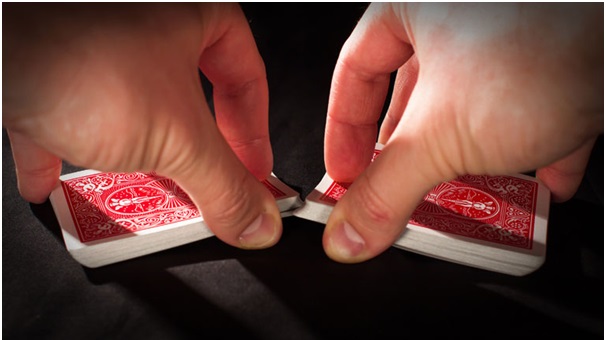
Blackjack Shuffle needs lots of practice and this is the shuffle that does the least damage to the cards. There’s minimal bending, but you get the same effect as an ordinary shuffle. With plenty of practice, this shuffle looks like you’re barely moving the cards at all.
- Square the deck (get it in a neat stack). Cut the deck so you have 2 stacks that are about equal in size, and square those. Lay the two stacks horizontally in front of you, with the two inside and bottom corners pointing directly at you.
- Put your thumbs against those two corners, and your index fingers against the opposite corners. Your other fingers should have a tight grip on the cards in place.
- Use your thumbs to draw the corners upward, draw the two halves of the deck closer together, then let the cards fall—like a regular shuffle, but only using a small corner of the deck. The very corners of the cards should now be shuffled together.
- Push the interconnected cards back together, square the deck, and repeat.
3. The Strip Shuffle
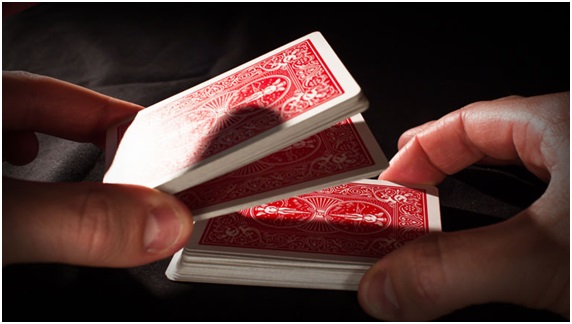
You must have seen in some casino that dealer take sections of the deck, put it down, then places the other half on top over and over again That’s a strip shuffle, or what’s also known as running cuts. The first step is to learn how to cut the deck to shuffle, a process a bit more dedicated than simply lifting off the top half of cards.
- For this place the deck facedown in front of you horizontally. With both hands, grasp the side closest to you with your thumbs, and the far side with your fingers. It may help to keep the fingers of your left hand raised slightly off the table, so that the deck is also elevated.
- With your right hand, grasp a small section of cards with your thumb and index fingers, and remove from the deck. Use your left hand to keep the rest of the deck in place.
- Place the small section of cards back into the deck—in the middle, at the bottom, wherever you want. Square the deck. Repeat 4-5 times with a different section of the deck.
4. Palm Strip Shuffle
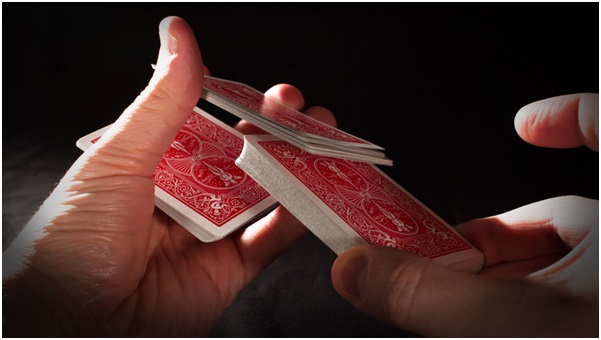
Palmed Strip Shuffle requires some practice to get it down correctly, but looks impressive once you have it right.
- Hold the deck pips-down in the palm of your left hand. Grip lightly. Your thumb and middle fingers should extend above the top of the deck.
- Using the index finger and thumb of your right hand, gently tug a section of the deck—about ¾ of the deck off the bottom—out in a single stack. Leave the remaining ¼ of the deck in your left hand.
- Hover the stack of cards in your right hand over the stack in your left hand. Using the middle finger and thumb of your left hand, pull a few cards from the stack in the top of your right hand. The right-hand cards should land on top of your left-hand stack.
- Continue taking out sections from the top of the stack in your right hand and placing it in your left hand. When you run out of cards in your right hand, take another ¾ of the bottom of the deck in your left hand, and repeat steps 1-4.
Shuffling cards with mathematics
According to Graham Kendall, Professor of Computer Science University of Nottingham most people will give a pack a few shuffles with the overhand or riffle methods (where the pack is split and the two halves are interweaved). But research has shown this isn’t enough to produce a sufficiently random order to make sure the card game being played is completely fair and to prevent people cheating.
Players have used shuffle tracking, where blocks of cards are tracked so that you have some idea when they will appear. If you are given the option to cut the pack, you try and cut the pack near where you think the block of cards you are tracking is so that you can bet accordingly. A variant on this is to track aces as, if you know when one is likely to appear, you have a distinct advantage over the casino.
According to the Professor Kendall to work out how many ways there are of arranging a standard 52-card deck, you multiply 52 by all the numbers that come before it (52 x 51 x 50 … 3 x 2 x 1). This is referred to as “52 factorial” and is usually written as “52!” by mathematicians. The answer is so big it’s easier to write it using scientific notation as 8.0658175e+67, which means it’s a number beginning with 8, followed by 67 more digits.
To put this into some sort of context, if you dealt one million hands of cards every second, it would take you 20 sexdecillion, or 20,000,000,000,000,000,000,000,000,000,000,000,000,000,000,000,000,000, years to deal the same number of hands as there are ways to arrange a deck of cards.
You would think that it would be easy to get a random order from that many permutations. In fact, every arrangement is, in a sense, random. Even one where the cards are ordered by suit and then rank could be considered random. It is only the interpretation you put on this order that would make most people not consider it random. This is the same as the idea that the lottery is less likely to throw up the numbers one to six, whereas in reality this combination is just as probable as any other.
In theory, you could shuffle a deck so that the cards emerged in number order (all the aces, followed by all the twos, followed by all the threes and so on), with each set of numbers in the same suit order (say spades, hearts, diamonds and clubs). Most people would not consider this random, but it is just as likely to appear as any other specific arrangement of cards (very unlikely). This is an extreme example but you could come up with an arrangement that would be seen as random when playing bridge because it offered the players no advantage, but wouldn’t be random for poker because it produced consistently strong hands.
But what would a casino consider random?
Mathematicians have developed several ways of measuring how random something is. Variation distance and separation distance are two measures calculated by mathematical formulas. They have a value of 1 for a deck of cards in perfect order (sorted by numbers and suits) and lower values for more mixed arrangements. When the values are less than 0.5, the deck is considered randomly shuffled. More simply, if you can guess too many cards in a shuffled deck, then the deck is not well shuffled.
The Best and Worst Ways to Shuffle Cards
Persi Diaconis is a mathematician who has been studying card shuffling for over 25 years. Together with Dave Bayer, he worked out that to produce a mathematically random pack, you need to use a riffle shuffle seven times if you’re using the variation distance measure, or 11 times using the separation distance. The overhand shuffle, by comparison, requires 10,000 shuffles to achieve randomness.
“The usual shuffling produces a card order that is far from random,” Diaconis has said. “Most people shuffle cards three or four times. Five times is considered excessive”.
But five is still lower than the number required for an effective shuffle. Even dealers in casinos rarely shuffle the required seven times. The situation is worse when more than one deck is used, as is the case in blackjack. If you are shuffling two decks, you should shuffle nine times and for six decks you need to shuffle twelve times.
Automatic Shuffle at casinos
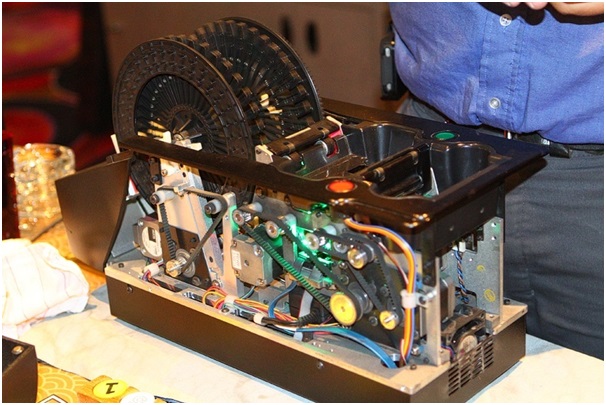
Many casinos now use automatic shuffling machines. This not only speeds up the games but also means that shuffles can be more random, as the machines can shuffle for longer than the dealers. These shuffling machines also stop issues such as card counting and card tracking.
But even these machines are not enough. In another study, Diaconis and his colleagues were asked by a casino to look at a new design of a card shuffling machine that the casino had built. The researchers found that the machine was not sufficiently random, as they simply did not shuffle enough times. But using the machine twice would resolve the problem.
So next time you’re at a casino, take a look at the technique with which the dealers shuffle cards.